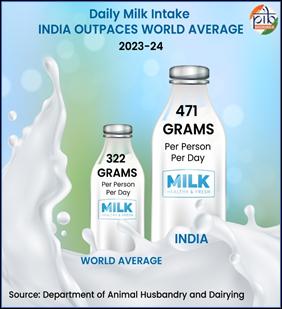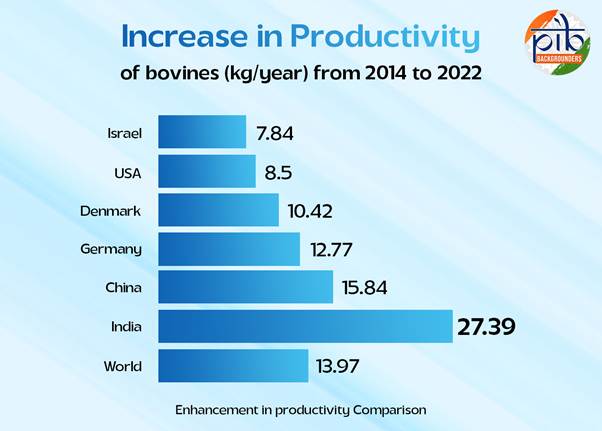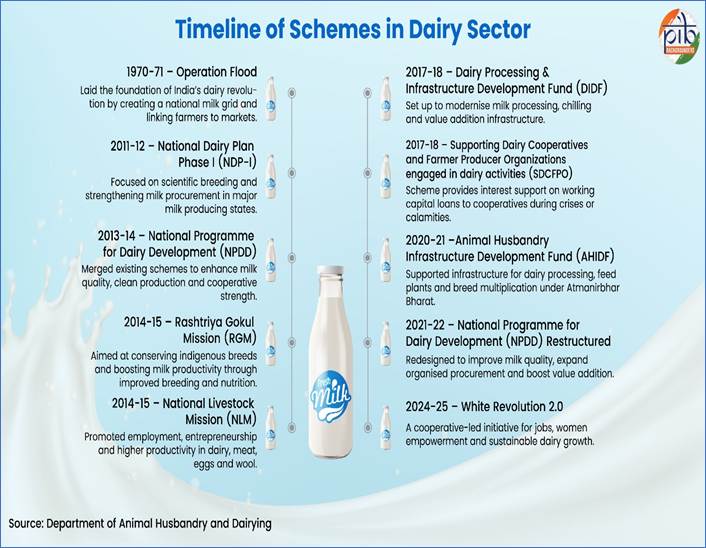India’s Dairy Dominance: Growth, Challenges, and the Road Ahead
Discover how India became the world’s largest milk producer, contributing 24% of global supply. Learn about the cooperative model, women’s leadership, technological advances, and government initiatives driving the dairy revolution, along with key challenges and future plans.
Context:
India’s dairy sector has registered 70% growth in the past 11 years, growing at the fastest pace in the world.
What is the Present Status?
Dairy is the largest agricultural commodity in India, contributing 5% to the national economy and directly employing over 8 crore farmers.
- Largest Producer: India holds the 1st position in global milk production for several consecutive years.
- Substantial Contribution: It contributes nearly a quarter (24%) of the world’s total milk supply.
- Sustained Growth: Milk production has seen an impressive surge, maintaining an annual growth rate of 5.7% over the last decade.
- Nutritional Security: Per capita availability of milk in India is significantly higher than the global average highlighting its central role in the nation’s nutritional security.

What Factors Have Led India to Achieve This Feat?
Several strategic and structural factors have been instrumental in India’s dairy success:
- Cooperative Model: The replication of the Anand pattern cooperatives under Operation Flood, spearheaded by the National Dairy Development Board (NDDB), created a robust farmer-owned network that eliminated middlemen and ensured fair prices for producers.
- Central Role of Women: Nearly 70% of the workforce in dairy farming consists of women. The establishment of over 48,000 women-led dairy cooperative societies and women-run Milk Producer Organisations (MPOs) has ensured inclusive growth and grassroots empowerment.
- Scientific Breeding and Genetic Upgradation: Initiatives like the Rashtriya Gokul Mission (RGM) have focused on the development and conservation of indigenous breeds and genetic upgradation, leading to a 27% growth in bovine productivity—the highest in the world.
- Technology Adoption: Widespread use of Artificial Insemination (AI), Sex-sorted semen, and In-Vitro Fertilization (IVF) labs has accelerated breed improvement. At the farm level, adoption of technologies like chaff cutters, milking machines, and silage units has enhanced efficiency and profitability.
- Government Support: Schemes like the Livestock Health Disease Control Programme (LHDCP) with Mobile Veterinary Units (MVUs) and the promotion of Ethno-Veterinary Medicine (EVM) have improved animal health and reduced disease incidence.

What are the Remaining Issues?
Despite its achievements, the sector faces several challenges:
- Low Artificial Insemination Coverage: Only 33% of breedable bovines are covered by artificial insemination. Nearly 70% are still serviced by scrub bulls of unknown genetic merit, which hampers productivity gains.
- Infrastructural Gaps: Issues like inadequate cold chain facilities, processing infrastructure, and logistical challenges in remote areas can lead to spoilage and inefficiencies.
- Animal Health and Fodder Management: Challenges related to the availability of quality fodder and the spread of livestock diseases remain persistent concerns for smallholders.
- Market Linkages for Small Farmers: While cooperatives are strong, many small and marginal farmers still lack direct access to organised markets, making them vulnerable to local price fluctuations.

What Initiatives Have Been Adopted?
The government has launched multiple initiatives to address these challenges and fuel further growth:
- Rashtriya Gokul Mission (RGM): A flagship scheme for indigenous breed development and genetic upgradation with a total allocation of Rs. 3400 crore for 2021-26.
- National Artificial Insemination Programme (NAIP): Provides free AI services at farmers’ doorsteps, having covered 9.16 crore animals and performed 14.12 crore AIs.
- MAITRIs Scheme: Trains Multipurpose AI Technicians in Rural India to deliver breeding and other services directly to farmers, with 38,736 technicians already inducted.
- Progeny Testing and Breed Multiplication: Scientific evaluation of bulls and establishment of 132 breed multiplication farms to ensure the supply of high-genetic-merit animals.
- White Revolution 2.0: A comprehensive five-year plan (2024-29) to:
- Form 75,000 new Dairy Cooperative Societies, with a focus on women.
- Strengthen 46,422 existing societies.
- Promote sustainability through Multi-State Cooperative Societies -(MSCS) for cattle feed, organic manure, and management of fallen animals.
The goal is not just to maintain global leadership in volume but to enhance the sector’s efficiency, inclusivity, and environmental sustainability, ensuring that the dairy revolution continues to be a primary driver of rural prosperity and nutritional security for all Indians.
Subscribe to our Youtube Channel for more Valuable Content – TheStudyias
Download the App to Subscribe to our Courses – Thestudyias
The Source’s Authority and Ownership of the Article is Claimed By THE STUDY IAS BY MANIKANT SINGH





